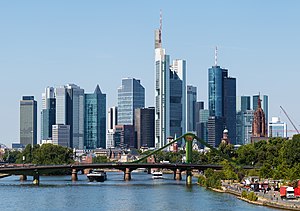Agentur für Arbeit

Frankfurt, the financial capital of Germany
|
|
| Currency | Euro (EUR) = € 1 = 1.17 USD |
|---|---|
| calendar year | |
|
Trade organisations
|
EU, WTO and OECD |
| Statistics | |
| GDP | $3.47 trillion (nominal; 2016) $3.98 trillion (PPP; 2016) |
| GDP rank | 4th (nominal) / 5th (PPP) |
|
GDP growth
|
0.6% (Q2 2017) |
|
GDP per capita
|
$41,902 (nominal; 2016) |
|
GDP per capita rank
|
17th (nominal) / 18th (PPP) |
|
GDP by sector
|
agriculture: 0.7%, industry: 30.2%, services: 69.1% (2015 est.) |
| 1.7% (2017) | |
|
Population below poverty line
|
16.7% (2015) |
| 30.7 (2015) | |
|
Labour force
|
44.2 million (2016) |
|
Labour force by occupation
|
agriculture (1.6%), industry (24.6%), services (73.8%) (2011) |
| Unemployment | 5.6% (July 2017) |
|
Average gross salary
|
€3,703 / $4,415 monthly (2016) |
| €2,269 / $2,590 monthly (2016) | |
|
Main industries
|
|
| 17th (2017) | |
| External | |
| Exports | $1.33 trillion (2016) |
|
Export goods
|
motor vehicles, machinery, chemicals, computer and electronic products, electrical equipment, pharmaceuticals, metals, transport equipment, foodstuffs, textiles, rubber and plastic products |
|
Main export partners
|
|
| Imports | $1.05 trillion (2016) |
|
Import goods
|
machinery, data processing equipment, vehicles, chemicals, oil and gas, metals, electric equipment, pharmaceuticals, foodstuffs, agricultural products |
|
Main import partners
|
|
|
FDI stock
|
$1.416 trillion (2016) |
|
Gross external debt
|
$5.084 trillion (31 March 2017) |
| Public finances | |
| 68.2% of GDP (2016) | |
| Revenues | $1.523 trillion (2016 est.) |
| Expenses | $1.497 trillion (2016 est.) |
| Economic aid | donor: ODA, $24.67 billion (2016) |
|
Standard & Poor's: AAA Outlook: Stable Moody's: Aaa Outlook: Stable Fitch: AAA Outlook: Stable |
|
|
Foreign reserves
|
$0.4 trillion (April 2015) |
The economy of Germany is a highly developed social market economy. It has the largest national economy in Europe, the fourth-largest by nominal GDP in the world, and fifth by GDP (PPP). In 2017, the country accounted for 28% of the euro area economy according to the IMF. Germany is a founding member of the European Union and the Eurozone.
In 2016, Germany recorded the highest trade surplus in the world worth $310 billion, making it the biggest capital exporter globally.Germany is the third largest exporter in the world with 1.21 trillion euros ($1.27 trillion) in goods and services exported in 2016. The service sector contributes around 70% of the total GDP, industry 29.1%, and agriculture 0.9%. Exports account for 41% of national output. The top 10 exports of Germany are vehicles, machineries, chemical goods, electronic products, electrical equipments, pharmaceuticals, transport equipments, basic metals, food products, and rubber and plastics. The economy of Germany is the largest manufacturing economy in Europe and it is less likely to be affected by the financial downturn and conduct applied research with practical industrial value and sees itself as a bridge between the latest university insights and industry-specific product and process improvements, and by generating a great deal of knowledge in its own laboratories as well. In July 2017, the International Monetary Fund gave the country's economy "yet another bill of good health" and some advice on steps it might take to maintain this level in the long run.
Germany is rich in timber, potash, salt, uranium, nickel, copper and natural gas. Energy in Germany is sourced predominantly by fossil fuels (50%), followed by nuclear power second, then gas, wind, biomass (wood and biofuels), hydro and solar. Germany is the first major industrialized nation to commit to the renewable energy transition called Energiewende. Germany is the leading producer of wind turbines in the world. Renewables now produce over 27% of electricity consumed in Germany.
...
Wikipedia
